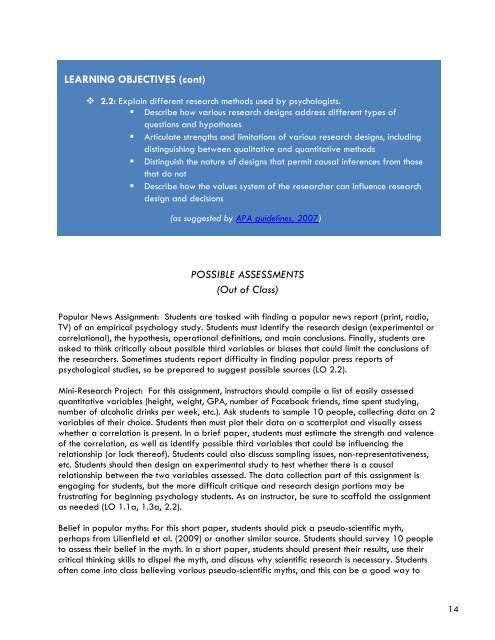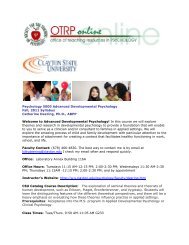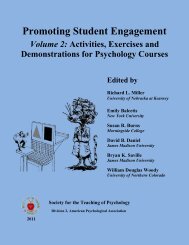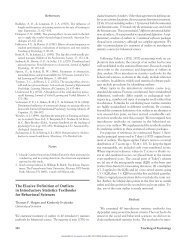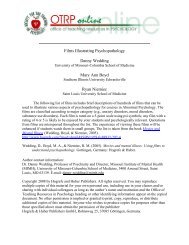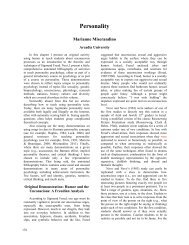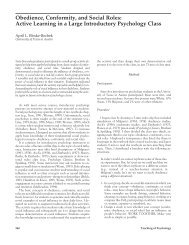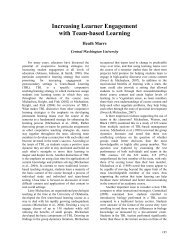INTRODUCTORY PSYCHOLOGY TEACHING PRIMER Early Career ...
INTRODUCTORY PSYCHOLOGY TEACHING PRIMER Early Career ...
INTRODUCTORY PSYCHOLOGY TEACHING PRIMER Early Career ...
You also want an ePaper? Increase the reach of your titles
YUMPU automatically turns print PDFs into web optimized ePapers that Google loves.
LEARNING OBJECTIVES (cont)<br />
2.2: Explain different research methods used by psychologists.<br />
Describe how various research designs address different types of<br />
questions and hypotheses<br />
Articulate strengths and limitations of various research designs, including<br />
distinguishing between qualitative and quantitative methods<br />
Distinguish the nature of designs that permit causal inferences from those<br />
that do not<br />
Describe how the values system of the researcher can influence research<br />
design and decisions<br />
(as suggested by APA guidelines, 2007)<br />
POSSIBLE ASSESSMENTS<br />
(Out of Class)<br />
Popular News Assignment: Students are tasked with finding a popular news report (print, radio,<br />
TV) of an empirical psychology study. Students must identify the research design (experimental or<br />
correlational), the hypothesis, operational definitions, and main conclusions. Finally, students are<br />
asked to think critically about possible third variables or biases that could limit the conclusions of<br />
the researchers. Sometimes students report difficulty in finding popular press reports of<br />
psychological studies, so be prepared to suggest possible sources (LO 2.2).<br />
Mini-Research Project: For this assignment, instructors should compile a list of easily assessed<br />
quantitative variables (height, weight, GPA, number of Facebook friends, time spent studying,<br />
number of alcoholic drinks per week, etc.). Ask students to sample 10 people, collecting data on 2<br />
variables of their choice. Students then must plot their data on a scatterplot and visually assess<br />
whether a correlation is present. In a brief paper, students must estimate the strength and valence<br />
of the correlation, as well as identify possible third variables that could be influencing the<br />
relationship (or lack thereof). Students could also discuss sampling issues, non-representativeness,<br />
etc. Students should then design an experimental study to test whether there is a causal<br />
relationship between the two variables assessed. The data collection part of this assignment is<br />
engaging for students, but the more difficult critique and research design portions may be<br />
frustrating for beginning psychology students. As an instructor, be sure to scaffold the assignment<br />
as needed (LO 1.1a, 1.3a, 2.2).<br />
Belief in popular myths: For this short paper, students should pick a pseudo-scientific myth,<br />
perhaps from Lilienfield et al. (2009) or another similar source. Students should survey 10 people<br />
to assess their belief in the myth. In a short paper, students should present their results, use their<br />
critical thinking skills to dispel the myth, and discuss why scientific research is necessary. Students<br />
often come into class believing various pseudo-scientific myths, and this can be a good way to<br />
14


